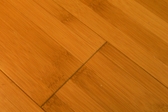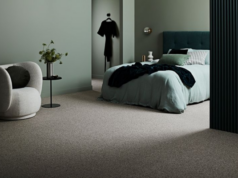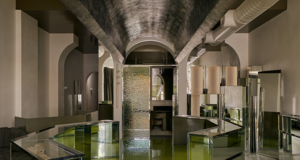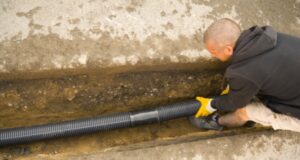
Bamboo offers a low-cost and sustainable alternative to hardwood timber floors. Learn more about how bamboo floors are made, and how they rate in terms of durability and longevity.

Bamboo flooring is becoming a popular alternative to conventional hardwood timber flooring these days, for a few reasons. It’s relatively cheap, grows quickly and has a fairly low environmental cost associated with its production.
Depending on how it’s manufactured and treated, bamboo can offer much greater hardness and durability than hardwoods too – reportedly up to three times harder than oak. Bamboo’s also highly resistant to insects and moisture, which makes it more suitable than conventional hardwood flooring for areas like kitchens.
While it hasn’t always been the case, recent innovations mean that bamboo floors these days are available in a very broad range of styles, colours and finishes – and if required, can very convincingly mimic hardwood floorboards.
Is bamboo a ‘wood’?
While the finished products may look, feel and behave like conventional hardwood timber in many ways, bamboo is technically a type of grass. There are more than 1450 species of bamboo, which grow differently and have very different properties – although in most cases, bamboo flooring is made from Moso bamboo (Phyllostachys edulis).
Bamboo’s a fairly thirsty kind of plant, and most of the bamboo that is used for bamboo flooring here comes from overseas (predominantly China), where it’s much cheaper to produce.
Are bamboo floors ‘greener’ than wooden floorboards?
In many ways, yes. The biggest advantage to bamboo is that it grows extremely quickly – in some cases up to a metre in a single day. Bamboo culms (the individual stems) can typically be harvested when the bamboo’s between 4 and 7 years old, and will produce an annual yield from that time onwards.
By contrast, fast growing hardwood trees only offer a one-time yield of timber, and are likely to take at least 15 years to reach ‘maturity’, where the timber’s suitable for harvest. Many prized hardwood timbers take much, much longer than that though.
While a lack of regulation and oversight in the industry has been a bit of a problem for bamboo in the past, in recent years there’s been a far greater push for responsible and sustainable farming methods that don’t damage biodiversity. Many bamboo manufacturers now go to great lengths to ensure that their products are farmed in ways that don’t damage existing forestry – and some now also carry Forest Stewardship Certification (FSC certification).
Moisture resistance and cupping
One of the main selling points of bamboo floors is that they’re less porous, and technically more resistant to moisture than conventional hardwood floorboards. For this reason they’re considered a less risky option than hardwood for installation in places like kitchens and laundries.
Having said that though, they are still susceptible to a bit of moisture. While they can be installed either on a concrete slab or fitted onto a timber subfloor, many installers recommend installing a moisture barrier under the boards to reduce the risk of ‘cupping’ (i.e. where the edges of the boards curl up). Another measure some manufacturers take to address cupping is to engineer an interlayer in the middle of the floorboard.
When cupping occurs, floorboards can be sanded flat again – although this obviously wears the edges of the boards down, which is likely to be a problem in particular for tongue-and-groove style boards.
How is bamboo flooring made?
The types of bamboo flooring we see in Australia are processed extensively to turn them into floorboard / floor tile types of products.
To form these products, the outer layer of skin and nodes are first cut away, and the bamboo is then cut into strips of a consistent width. Bamboo’s at its strongest with its starch and sugar removed, so these strips are then normally boiled in boric acid to remove these elements.
Once that’s finished, the strips are dried out, after which they may be subjected to a steaming and heat treatment known as ‘carbonising’. Carbonising bamboo gives it a dark colour, but also significantly reduces its hardness.
Horizontal and vertical lamination
From there, the bamboo strips are often laminated together to form boards. This is normally achieved by either laminating the strips horizontally, or vertically – each method giving a different finish.
- Vertically laminated bamboo – This type of bamboo floorboard is made by standing the strips of bamboo on their thinnest edge and laminating them together. This gives face of the finished board a kind of ‘stripey’ look.
- Horizontally laminated bamboo – For these boards, the strips of bamboo are laid out on their widest edge and laminated together. The resulting board shows up the characteristic nodes from the bamboo.
Strand woven bamboo flooring
Another common production method is strand weaving. Strand woven bamboo boards are usually much more expensive (often twice the price as the other types), but when made right are extremely hard and durable. In fact, the best strand-woven bamboo floorboards can easily outperform just about any hardwood timber in terms of hardness. Good strand-woven bamboo floorboards can measure roughly between 13.3kN (3000lbf) and 22.2kN (5000lbf) on the Janka hardness scale. For comparison, the hardness of grey ironbark is roughly around 16.3kN.
Strand woven bamboo is made by taking individual strands of bamboo that have been softened, thrashing, weaving and bundling them together and then compressing them under heat with a binding agent to form a block which is then cut into boards.
Depending on your tastes, these boards can be made either of ‘natural’ coloured bamboo (which is lighter), carbonised bamboo (which is darker), or a tiger-striped combination of the two.
Planks and boards
Once they’ve been made into planks, bamboo floorboards are normally either cut into straight boards that can be nailed or glued in, or formed into click-together tongue-and-groove style boards. The boards are often bevelled slightly around the edges for easy fitting.
Finishes and treatments to protect bamboo floors
Bamboo floorboards need to be finished with several coats of polyurethane, acrylic, and various other finishes that combine with aluminium oxide to create a protective barrier, which helps to preserve the look and integrity of the boards.
It’s important that this finish is carefully maintained to ensure that the boards don’t scratch or degrade, and most manufacturers provide specific care instructions that need to be followed very carefully in order to maintain your warranty.
VOCs and Health concerns
Like many laminated timber products, an adhesive is needed to glue the bamboo parts together. These are often volatile organic compounds (or VOCs), which release toxic gases into the air – particularly when the products are fairly new.
Most bamboo flooring is laminated using a urea-formaldehyde (UF) which does emit some VOCs into the air, although it’s a relatively small amount when compared with other products like medium density fibreboard (MDF). Some products avoid urea formaldehyde for the purpose of lamination for this reason.
|
Advantages
|
Disadvantages
|





